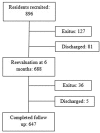Characteristics, consequences and prevention of falls in institutionalised older adults in the province of Malaga (Spain): a prospective, cohort, multicentre study
- PMID: 29476031
- PMCID: PMC5855255
- DOI: 10.1136/bmjopen-2017-020039
Characteristics, consequences and prevention of falls in institutionalised older adults in the province of Malaga (Spain): a prospective, cohort, multicentre study
Abstract
Objectives: Falls are an important adverse event among institutionalised persons. It is in this clinical setting where falls occur more frequently than in any other, despite the measures commonly taken to prevent them. This study aimed to determine the characteristics of a typical institutionalised elderly patient who suffers a fall and to describe the physical harms resulting from this event. We then examined the association between falls and the preventive measures used.
Methods: This was a prospective cohort study in 37 nursing homes in Spain. The participants were all the nursing home residents institutionalised in these centres from May 2014 to July 2016. Participants were followed up for 9 months. During this period, two observations were made to evaluate the preventive measures taken and to record the occurrence of falls.
Results: 896 residents were recruited, of whom 647 completed the study. During this period, 411 falls took place, affecting 213 residents. The injuries caused by the falls were mostly minor or moderate. They took place more frequently among women and provoked 22 fractures (5.35%). The most commonly used fall prevention measure was bed rails (53.53% of cases), followed by physical restraint (16.79%). The latter measure was associated with a higher incidence of injuries not requiring stitches (OR=2.06, 95% CI 1.01 to 4.22, P=0.054) and of injuries that did require stitches (OR=3.51, 95% CI 1.36 to 9.01, P=0.014) as a consequence of falls. Bed rails protected against night-time falls.
Conclusions: Falls are a very common adverse event in nursing homes. The prevention of falls is most commonly addressed by methods to restrain movement. The use of physical restraints is associated with a greater occurrence of injuries caused by a fall.
Keywords: accident prevention; accidental fall; nursing homes; physical restraint.
© Article author(s) (or their employer(s) unless otherwise stated in the text of the article) 2018. All rights reserved. No commercial use is permitted unless otherwise expressly granted.
Conflict of interest statement
Competing interests: None declared.
Figures


Similar articles
-
Use of physical restraints in nursing homes and hospitals and related factors: a cross-sectional study.J Clin Nurs. 2012 Apr;21(7-8):1033-40. doi: 10.1111/j.1365-2702.2011.03931.x. Epub 2011 Dec 19. J Clin Nurs. 2012. PMID: 22176771
-
Physical restraint use and falls in nursing home residents.J Am Geriatr Soc. 1996 Jun;44(6):627-33. doi: 10.1111/j.1532-5415.1996.tb01822.x. J Am Geriatr Soc. 1996. PMID: 8642150
-
Side rail use and bed-related fall outcomes among nursing home residents.J Am Geriatr Soc. 2002 Jan;50(1):90-6. doi: 10.1046/j.1532-5415.2002.50013.x. J Am Geriatr Soc. 2002. PMID: 12028252
-
Why do we use physical restraints in the elderly?Z Gerontol Geriatr. 2005 Feb;38(1):19-25. doi: 10.1007/s00391-005-0286-x. Z Gerontol Geriatr. 2005. PMID: 15756483 Review.
-
Falls and fall prevention in the nursing home.Clin Geriatr Med. 1996 Nov;12(4):881-902. Clin Geriatr Med. 1996. PMID: 8890121 Review.
Cited by
-
The Use of Static Posturography Cut-Off Scores to Identify the Risk of Falling in Older Adults.Int J Environ Res Public Health. 2022 May 26;19(11):6480. doi: 10.3390/ijerph19116480. Int J Environ Res Public Health. 2022. PMID: 35682064 Free PMC article.
-
Physical Restraint Use in Nursing Homes-Regional Variances and Ethical Considerations: A Scoping Review of Empirical Studies.Healthcare (Basel). 2023 Aug 4;11(15):2204. doi: 10.3390/healthcare11152204. Healthcare (Basel). 2023. PMID: 37570444 Free PMC article. Review.
-
Translation and psychometric evaluation of the Witness Perceived Safety Scale of prehospital emergency care.BMC Emerg Med. 2025 Apr 18;25(1):65. doi: 10.1186/s12873-025-01226-8. BMC Emerg Med. 2025. PMID: 40251496 Free PMC article.
-
Health Consequences of Falls among Older Adults in India: A Systematic Review and Meta-Analysis.Geriatrics (Basel). 2023 Apr 18;8(2):43. doi: 10.3390/geriatrics8020043. Geriatrics (Basel). 2023. PMID: 37102969 Free PMC article. Review.
-
Evaluation of emergency medical responses to nursing homes in a local area of Germany.BMC Emerg Med. 2025 Aug 5;25(1):148. doi: 10.1186/s12873-025-01306-9. BMC Emerg Med. 2025. PMID: 40765042 Free PMC article.
References
-
- World Health Organization. Falls. fact sheet No. 344. 2016. http://bit.ly/1i7Ixzq
-
- World Health Organization. WHO global report on falls prevention in older age. 2007. http://bit.ly/1IltXUR
-
- da Silva Gama ZA, Gómez Conesa A. Morbilidad, factores de riesgo y consecuencias de las caídas en ancianos. Fisioterapia 2008;30:142–51. 10.1016/S0211-5638(08)72972-9 - DOI
Publication types
MeSH terms
LinkOut - more resources
Full Text Sources
Other Literature Sources
Medical
